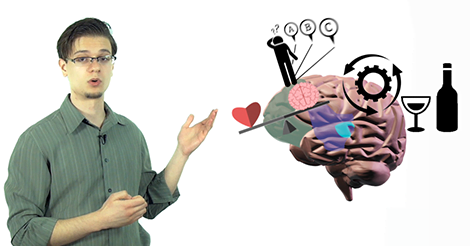The Science of Addiction
There is sometimes controversy in the field of addiction recovery as to whether addiction is a disease or not. For the most part, recovery services around the country use the disease model when treating addicts, and there is a plethora of statistics used to back up this model.
Sadly, controversy still exists in this field, especially among the country’s populace. This web series, Science of Addiction, is hosted by research analyst Reisto Belovich, he will break down the activity in the brain when it comes to addiction.
“Before we can understand the full sway of addiction, it would make sense for us to understand the primary areas of the brain that are affected by addiction,” Belovich said.
The brain controls our entire body through electrical stimulus that allows us to think, feel, move, breathe, speak, and every other minute motion the body goes through. When it comes to addiction, there are three areas primarily associated with addiction.
The first is the Prefrontal Cortex, which is responsible for the executive functions in the brain. Our reasoning and understanding, the decisions we make based on what we believe is good or bad, and the logic we use to process these thoughts all come from the Prefrontal Cortex.
Any time you are weighing the pros and cons of something your Prefrontal Cortex is the part of the brain that is processing those thoughts and putting them into action.
The second is the Limbic System, also known as the Reward Circuit of the brain. Belovich offers the example of cake: The first time you had cake it was likely delicious that triggered the Limbic System and told it that cake would be good to have again.
“This is responsible for remembering a lot of pleasant experiences,” Belovich said.
When drugs or alcohol are put into the system, this part of the brain remembers the good feelings they brought on and tells the body it would be fun to do this again.
The third is the Midbrain. This part of the brain is responsible for all of our survival functions, including our vision, hearing, and even our fight or flight response.
“The Midbrain is responsible for the next 15 seconds, and does not view anything outside of that time.”
Truth be told, the Midbrain does not need to view anything past that, because it’s job is to ensure survival.
Substance Administration: The Brain’s Reaction
There is something called dopamine that acts as a neurotransmitter; a chemical substance that is released at the end of a nerve fiber by the arrival of a nerve impulse and, by diffusing across the synapse or junction, causes the transfer of the impulse to another nerve fiber, a muscle fiber, or some other structure. Neurotransmitters are also known as chemical messengers.
“Dopamine is primarily responsible for a lot of cognitive functions, movement, and some senses of euphoria, but not to the scale of when you are actually using drugs or alcohol.”
When a substance such as Heroin enters your body, there is an inordinate surge of dopamine. Any psychoactive substance causes an inhuman amount of dopamine that is impossible to replicate naturally, or without said substance.
The brain even has difficulty processing just how much dopamine has been surged into the system. All of this combined is what makes drugs and alcohol so addictive, and what makes them impossible to stop through shear willpower.
In response to the massive dopamine dump, we also have a release of another neurotransmitter called Glutamate. This is responsible for our memory functions: detail, touch, smell, and it even effects the nature of the Midbrain.
The more Glutamate that is released at a certain point, the more likely we are to remember something and the more detail we have of that memory.
“When you have these many neurotransmitters going on, the Midbrain becomes more and more sensitive to the needs of using drugs or alcohol … making it a higher priority in the brain’s functioning.”
Belovich shows an excellent image of a pyramid that categorizes our needs from lowest (the top of the pyramid) to highest (the bottom/larger part of the pyramid). Self-Actualization, Self-Esteem, Sense of Belonging, Safety Needs, and Physiological Needs. As with any pyramid-graph-example, the greater the need the lower on the pyramid it is to show that it is a larger necessity. What these substances do is blur these needs, focusing entirely on the addiction itself.
Why Can’t We Just Stop?
Belovich poses a wonderful question, “If drugs and alcohol can be so dangerous to the nature of the brain that it completely rewires it into a repeated pattern of use, why not just stop? Why doesn’t the Prefrontal Cortex actually make the executive decision that drugs and alcohol are not good…?”
We all wish for simplicity, but if science has taught us anything it is that the human brain is not a simple thing.
The answer to this question lies in the Midbrain, which is significantly closer to the spinal cord than the other parts that are involved with addiction. With addiction, the Midbrain is highly overstimulated, and because it is closer to the spine, all the electrical signals hit the Midbrain long before the Prefrontal Cortex.
In short, long before the brain can make an executive call on whether or not a drink, a line of Cocaine, or a shot of Heroin are a good or bad choice, the Midbrain is already stimulated. The Limbic system is going crazy, and the brain believes the substance is a necessity of life.
“In essence, before you even have a chance to consider the choice of addiction, most of your brain has already made up its mind as to whether or not it wants to use.”
Everything boils down to the brain; All of our functions, thoughts, and motions are affected and governed by it, and addiction takes what we have and reorganizes it before we even have a chance to protest.








